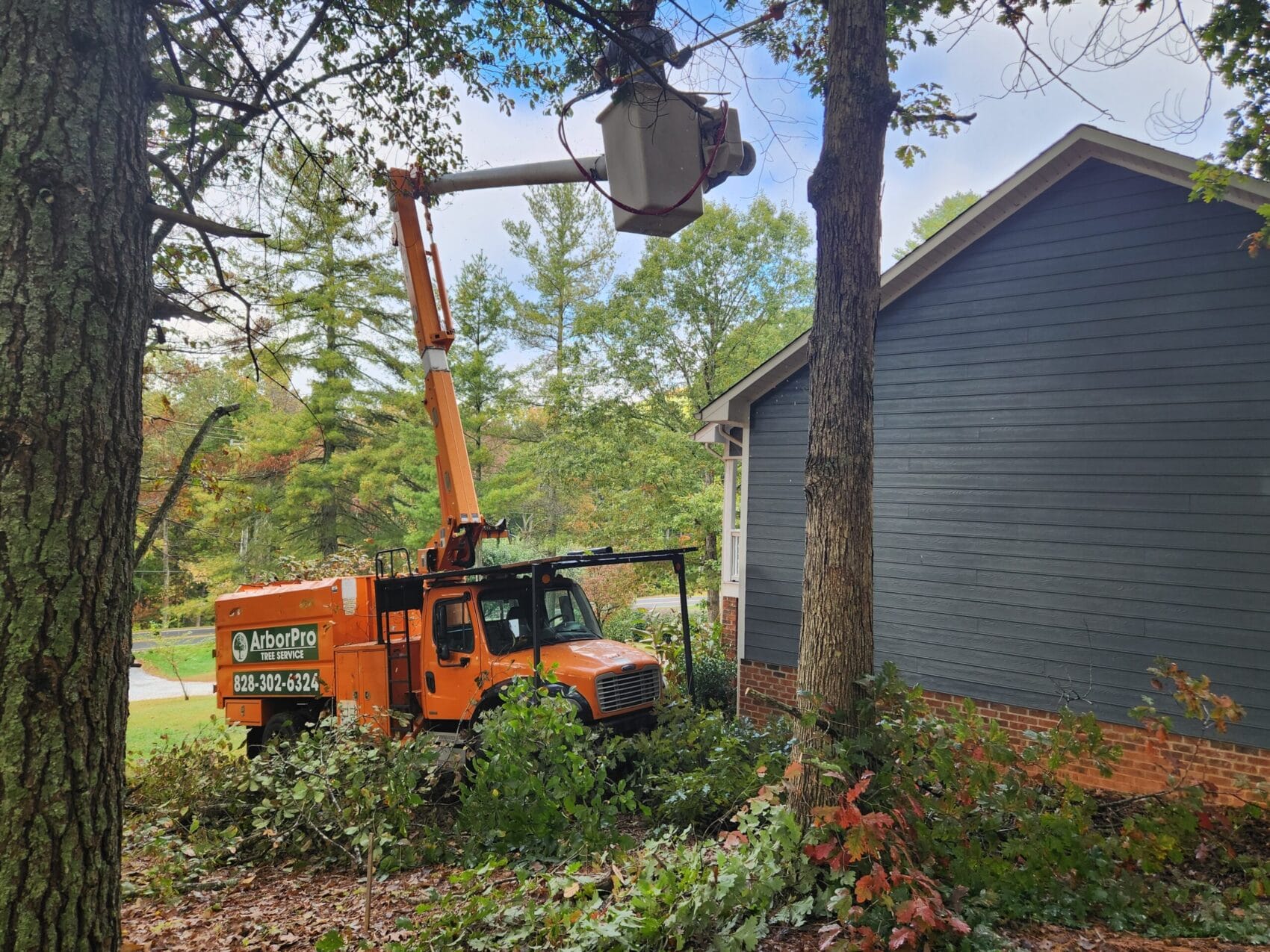
Removing a large pine or oak tree on your own can lead to serious injury, costly property damage, or even legal fines. Homeowners in Hickory, NC, can face unique risks when attempting do-it-yourself (DIY) tree removal in densely wooded yards. This article explains why a certified tree removal service delivered by ArborPro Tree Service is the safest route.
Attempting tree removal without professional guidance means you’ll have to have a great understanding of the heavy equipment used, complex physics, and unpredictable tree behavior. This section defines the top hazards, explains why they occur, and introduces the life- and property-saving role of expert arborists.
DIY tree cutting often leads to falls, chainsaw kickbacks, or being struck by falling branches. A chainsaw’s sudden reverse force can sever limbs, while unstable ladders and slick bark increase fall risk. Statistics show hundreds of people suffer serious injuries every year from solo tree work. These accidents highlight why professionals train extensively in climb safety, rope rigging, and fall-arrest systems, ensuring no one ends up hurt.
Uncontrolled tree felling can crush roofs, shatter windows, or sever power lines. A single 60-foot oak usually weighs over a thousand pounds. So, without rigging equipment, its descent is both unpredictable and destructive.
Here are the top risks associated with DIY tree cutting:
Professionals use cranes, rigging pulleys, and drop-zone assessments to guide each segment safely away from structures. Preventing collateral damage naturally also leads to avoiding electrocution hazards when trees grow near utilities.
Working within 10 feet of live wires risks fatal electric shock or power outages for entire neighborhoods. Hidden wires obscured by foliage amplify danger. When branches touch energized conductors, current can arc unexpectedly. Utility protocols require notifying power companies, yet DIY efforts rarely account for underground cables or municipal easements. Expert crews coordinate directly with utilities to de-energize lines or employ insulated tools rated for electrical work, eliminating life-threatening surprises and reinforcing the importance of licensed assistance before discussing financial liabilities.
Without proper permits or insurance, DIY removals can void homeowner policies and incur municipal fines. A misdirected log can land on a neighbor’s property, triggering litigation for negligence.
The most common liabilities include the following:
Hiring an insured tree removal service guarantees liability coverage and expert permit handling, shifting us to the final DIY risk: the hidden cost of ignorance.
Understanding tree biology—rot patterns, branch weight distribution, disease signs—is critical to safe felling. DIY cutters often miss decay cavities or internal splits, causing sudden trunk failures. Professionals perform detailed risk assessments, mapping out hinge wood, load path, and escape routes to control tree sections intentionally. Expertise prevents unexpected collapses and prepares crews for complex cuts, bridging seamlessly into the many safety benefits of professional removal.
Certified arborists hold International Society of Arboriculture (ISA) credentials and master tree biology, risk assessment, and proper tree pruning techniques. They can also:
This expert assessment ensures removals follow best practices, reducing hazardous surprises and leading directly to how high-tech tools amplify safety.
Taking down a tree isn’t just about a saw and some muscle—the right gear makes all the difference. From bucket trucks to stump grinders, these tools keep the job safe and under control every step of the way.
Tree work can be unpredictable, so crews rely on proven systems that keep both people and property out of harm’s way.
These layered protocols create a controlled worksite where every cut and every crew member operates within a managed safety framework, paving the way to understanding why proper licensing and insurance are just as essential.
Beyond the cut, removing debris quickly prevents trip hazards and pest infestation. Professionals provide the following:
Controlled cleanup restores site safety and aesthetic appeal, completing the full circle of a professional service.
A professional crew’s playbook includes rigorous procedures at every stage. This section goes into more detail about the core protocols that ensure zero-incident outcomes.
Tree work can get risky fast, and that’s where PPE comes in. From helmets to gloves, every piece is there to keep crews safe while the sawdust flies.
Wearing the right gear for each task guarantees that crews stay protected, leading us to hazard assessment steps before any tree cutting begins.
Before a single cut is made, you’ve got to know what you’re dealing with. Hazard assessment spots the hidden dangers and shapes the game plan for a safe takedown. This involves the following:
This structured assessment pinpoints potential failure modes and informs rope rigging plans, seamlessly transitioning to how teams manage drop zones and communication.
When big branches start coming down, everyone needs to know where to be and where not to be. Clear drop zones and constant communication keep the whole crew in sync and out of danger.
This orchestration ensures everyone stays out of harm’s way, preparing the environment for emergency plan activation if needed.
Choosing professional tree removal in Hickory’s heavily wooded neighborhoods provides unmatched safety and peace of mind. ArborPro Tree Service’s certified arborists, specialized equipment, and proven protocols protect your family and property from the known dangers of DIY cutting. Contact us today for a free estimate and experience how our expert crews turn complex removals into seamless, secure solutions.
Granite Falls NC 28630
Mon - 24 hours
Tue - 24 hours
Wed - 24 hours
Thur - 24 hours
Fri - 24 hours
Sat - 24 hours
Sun - Closed